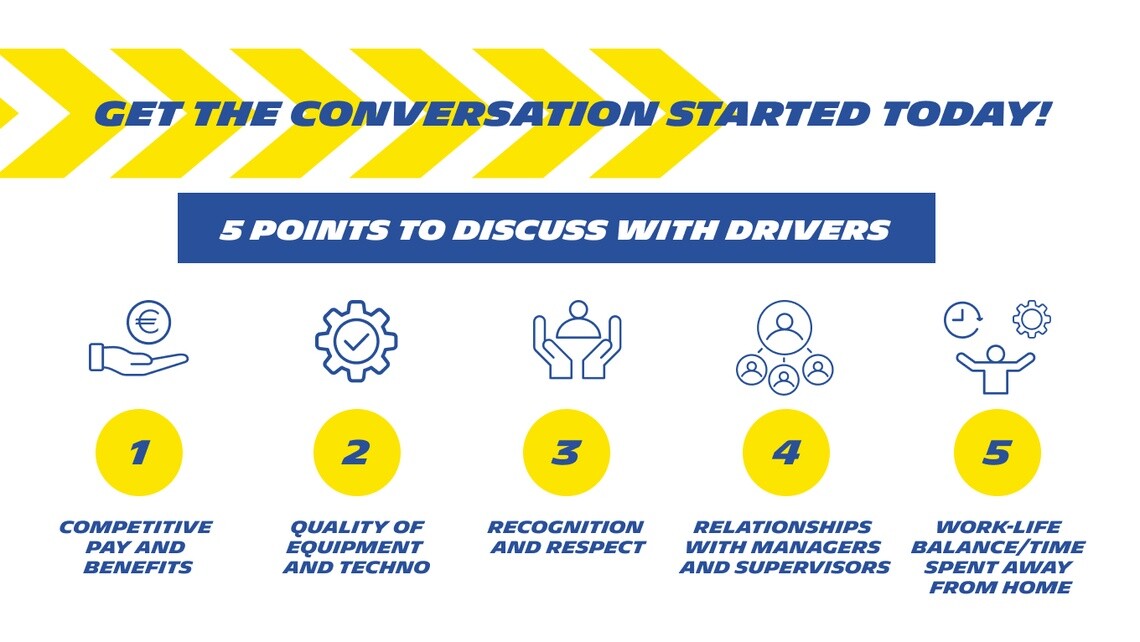
how driver feedback systems improve overall truck driver satisfaction
European companies are ramping up efforts to tackle the truck driver shortage, with over 70% exploring strategies to attract and retain drivers1 ౼ including more secure working conditions, installing more high-tech equipment and adopting rewards programs. But what’s the most effective way for fleet owners to truly understand and meet their drivers’ needs and eventually ensure truck driver satisfaction?
The answer is simple: ask them. While it might seem straightforward, gathering driver feedback can take many forms—from informal chats at the coffee machine to structured annual surveys or tech-based solutions that provide continuous insights throughout the year. Discover five tips to get connected with your fleet and start on a better path forward, today.
Regardless of the method, the key is to collect driver feedback consistently and act on it, ensuring drivers feel heard and valued. To get started, focus on gathering insights from the key points outlined below:

enhance overall truck driver satisfaction by starting the conversation today
The power of feedback: enhancing truck driver satisfaction, safety and performance
- Receiving feedback is crucial, especially given that only 49% of UK truck drivers and 51% of US truck drivers2 report feeling motivated to work for their company, with poor communication being the most common criticism3. This highlights a pressing need for better communication and engagement with management and emphasises the importance of proactive efforts to address their concerns. Listening to, acting on and incorporating driver feedback into management practices is a win-win strategy, addressing driver concerns while optimising fleet operations for long-term success.
Happy truck drivers can reduce the burden of high turnover costs, which are estimated at £8,000 to £15,000 per driver4.
Beyond retention, input from drivers often identifies actionable opportunities to improve work environments, streamline operations and boost overall fleet performance. Requesting feedback can also lead to safety improvements, such as optimising routes, flagging maintenance concerns or tailoring training programs ౼ all of which contribute to a safer environment and lower accident rates.
Drivers, often the first to notice mechanical inefficiencies, can also provide feedback that reduces maintenance costs and improves fuel efficiency. Beyond these practical advantages, requesting feedback and implementing changes fosters a culture of respect and inclusion, boosting morale and day-to-day performance.
Increase satisfaction by implementing an effective truck driver feedback system
Tip 1: Define the scope
The first step in developing a successful feedback system for fleet owners is to identify key challenges and define objectives. Do you want to find ways to reduce costs? Boost driver retention? Improve your company culture? Once you have your objective in mind, set specific, measurable goals for your feedback system.
Tip 2: Choose the right platform
The key to an effective feedback system is finding a solution that not only encourages drivers to participate but also ensures their input is candid and honest. Your choice of a user-friendly platform should align with your specific goals, company culture and budget. For some fleets, this might mean implementing an anonymous feedback tool that provides a 360° approach — sourcing unbiased input, presenting actionable insights to management and ultimately showing drivers how their feedback has driven positive changes within the fleet.
Marten Transport5 in the US has been using the WorkHound smartphone app, for example, to initiate two-way, anonymous if desired, conversations between drivers and managers. The anonymity leaves room for total honesty, boosts interaction and serves as a source of actionable improvements. Companies can also opt for driver surveys, such as the customisable survey on the CarriersEdge platform6, which includes any number of questions and can be used to target specific groups.
For more budget-conscious fleets, a simpler approach could involve directly collecting feedback from drivers and publicly sharing improvement plans via social media. This strategy has a dual advantage: it strengthens internal communication by demonstrating transparency and also highlights your fleet’s openness to external audiences. Such visibility can enhance your reputation and potentially attract new hires or clients eager to work with a company that values honesty and innovation.
Tip 3: Establish effective communication routines
If your feedback system were to have a mantra, it should be “early and often.” Gathering input from the very beginning, especially during the onboarding process, is crucial. This period is not only when drivers are most likely to leave — typically within the first 90 days7 — but also when you have the best opportunity to introduce new hires to your company culture and establish strong communication channels.
Ongoing touchpoints: the sooner, the better!
For instance, PGT Trucking8 uses an ‘ops interview’ to connect Fleet Managers with potential hires early in the process, providing real-time feedback, clearly communicating expectations and building trust from the outset. They also hold regular, face-to-face check-ins, including weekly meetings to give drivers a safe space to discuss concerns, request time off or ask questions. These ongoing touchpoints not only encourage open dialogue but also create a supportive environment where drivers feel heard, increasing retention and improving overall job satisfaction.

collect as much driver feedback as early as possible to enhance job satisfaction
Two truck drivers engage in a conversation about logistics while standing between parked trucks in a transport yard. The bright blue sky adds to the vibrant atmosphere of this bustling environment.
Mentor programmes
Pairing new drivers with seasoned colleagues during their first few months is another effective strategy. This peer-to-peer relationship fosters open communication, giving new hires a safe space to share their thoughts on how they’re adjusting and open the door to discussing potential improvements. This approach not only supports truck driver satisfaction and retention but also creates a culture of collaboration and shared learning.
The “open-door” policy
To maintain a strong feedback system, it’s essential to generate input on an ongoing basis. An "open-door" policy is a great starting point, sparking spontaneous conversations and making it clear that drivers’ thoughts and concerns are always welcome. Beyond informal exchanges, scheduling regular check-ins or monthly surveys ensures that drivers have consistent opportunities to share their ideas.
Quarterly team meetings
Quarterly team meetings can be another valuable tool, providing a forum for discussing overall performance, requesting feedback, and collaboratively addressing challenges. To keep communication flowing, consider sending out regular company newsletters or social media updates. These not only reinforce transparency but also help drivers feel connected to broader company initiatives.
Tip 4: Measure and share progress
Tracking the specific, measurable goals defined at the outset is crucial for long-term success. These key indicators might include levels of truck driver satisfaction, participation rates, qualitative or quantitative feedback trends or the number of actions implemented based on driver input.
Whatever metrics you choose, consistency in monitoring them is essential. Regularly sharing these results with your drivers demonstrates that their feedback is valued and respected. This type of communication helps keep your fleet informed about challenges or changes ౼ which can prevent the spread of rumours or misinformation.
Tip 5: Act on feedback received
Acting on feedback is arguably the most critical step in the process. When drivers take the time to provide candid insights, they expect more than acknowledgment—they expect action. Failing to act on their input risks undermining trust and discouraging future participation.
This involves analysing the data, comments and suggestions provided. When appropriate, discuss these insights directly with drivers to ensure clarity. This approach helps drivers feel like active contributors to the company’s goals and future. Equally important is celebrating the successes that stem from your feedback system.
Generating driver feedback: start small, think big
Whether you choose a fully digital feedback system or a grassroots, face-to-face approach, remember that your fleet is made up of individual drivers with unique perspectives, valuable insights and personal experiences. Nurturing this human connection provides a wealth of actionable input that can drive growth — if you make the effort to cultivate it.
Feeling overwhelmed by the options? Start small. Open the door to communication with something as simple as a phone call, a text message or a casual lunch with one of your drivers. These small gestures signal your commitment to listening and can lay the foundation for a more structured feedback system. No matter the scale of your investment, the returns — in retention, morale and operational success — will undoubtedly be worth it.

how to hire and keep the best drivers more about truck driver satisfaction in our white paper
FAQ :
Only 49% of truck drivers in the UK reported feeling motivated to work for their company, with poor communication being the most common criticism (see sources 2-3).
You can begin measuring job satisfaction by establishing an effective feedback system targeting drivers in your fleet. Be sure to clearly define the goals and scope of your feedback system, choose a format that works with your company culture and within your budget and communicate with your drivers to boost engagement. Most importantly, measure progress, act on feedback and share progress!
One of the best ways to boost truck driver satisfaction is to reach out early and often, asking for feedback on various aspects of their job and using their insight to create lasting change. Also, consider implementing an anonymous feedback system ౼ via an app or a simple “suggestions box” placed in your office ౼ which allows your drivers to express themselves freely.
1. IRU
https://www.iru.org/resources/iru-library/europe-truck-driver-shortage-report-2023
2. Trans.info
https://trans.info/en/only-30-of-lorry-drivers-feel-valued-finds-new-research-193052
3. Fleet Owner
https://www.fleetowner.com/operations/article/21262228/workhound-report-emphasizes-communication-for-happier-truck-driver
4.Bright Order UK
https://brightorder.co.uk/can-we-really-do-something-about-driver-turnover/
5. Transport Topics News
https://www.ttnews.com/articles/marten-turns-workhound-driver-feedback?utm
6. Fleet Owner
https://www.fleetowner.com/operations/drivers/article/21695459/gaining-feedback-from-drivers
7. Workhound
https://workhound.com/wp-content/uploads/2017/05/Why-Driver-Feedback-is-the-Key-to-Retention-EBook.pdf
8. FreightWaves
https://www.freightwaves.com/news/fleet-manager-driver-relationship-essential-to-success

gettyimages 930571046
car going fast on a road by night







